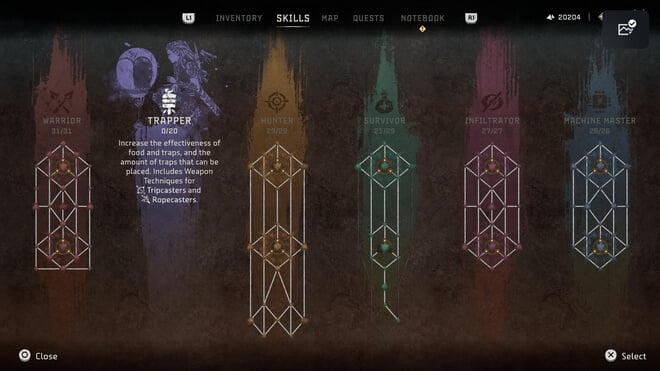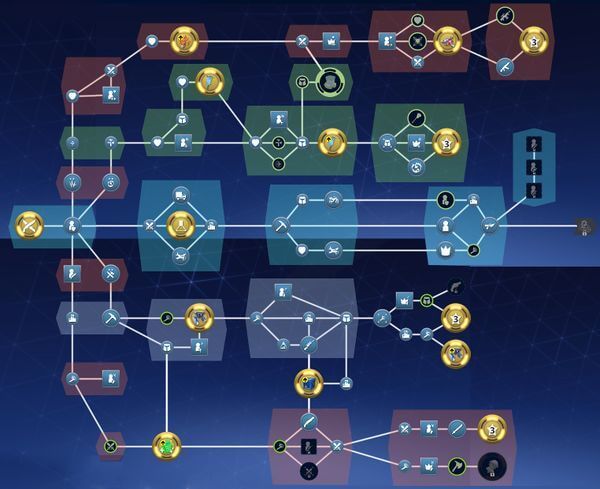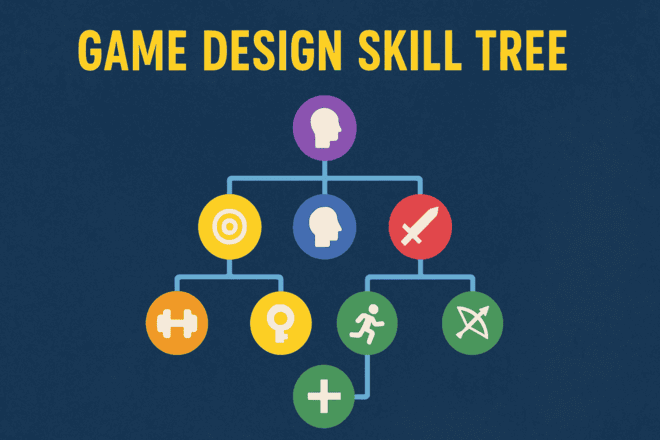What Is a Skill Tree
If you’re new to game design, think of skill trees as a branching roadmap of abilities. Players start at the base and unlock new skills as they play. Each branch leads to different playstyles.
The idea came from tech trees in old board games like Civilization. But it was Diablo II that brought it into video games in a big way. That game’s trees gave players active and passive skills, limited points to spend, and visual branches that made planning exciting.
I’ll never forget my first time playing Diablo II as a kid. I spent hours on forums and even drew my Sorceress’s skill plan on graph paper. Planning the build was half the fun. Later, in Path of Exile, I spent whole evenings theorycrafting character builds before I ever logged in. That’s the kind of anticipation a good skill tree creates.
In contrast, I once prototyped a small RPG where I forgot to include a skill tree. Playtesters said the combat felt static because there was nothing to unlock, no sense of progression. Adding a tree—even a small one—immediately made the game more engaging.
Key Takeaways
Skill trees are everywhere in modern games. You’ve seen them in Assassin’s Creed, God of War, Spider-Man, and probably a dozen RPGs you’ve played.
At their best, they make you feel powerful, let you shape your character to your playstyle, and give you exciting choices to look forward to.
At their worst, they’re bloated menus of +5 percent damage upgrades that you click through without thinking.
As a designer, your job is to make skill trees that players actually care about.
This guide will show you how to do it, from the basics of what a skill tree is, to common pitfalls, and practical tips for building one that players will remember.
Why Do Games Use Skill Trees

Skill trees aren’t just there to give players something to click on. They serve real purposes in game design.
They help manage complexity. Imagine if God of War started with every move unlocked. It would be overwhelming. Instead, Kratos’s skill tree introduces new combos gradually, keeping players engaged without overloading them.
They create agency. In Assassin’s Creed Origins, I focused my points on the Hunter and Seer branches. This turned Bayek into a stealth-focused trickster in my playthrough. But my friend went all-in on Warrior and became a tank. Those choices made our games feel unique.
Skill trees also drive replayability. When I replayed Horizon Zero Dawn, I tried a totally different build and it felt like a new game.
And let’s be honest—they look cool. The UI team gets to make flashy icons and themed layouts that reinforce the game’s world.
According to the 2023 GDC survey, over 75 percent of games released that year used skill trees or something similar. But here’s the catch: only a few felt truly exciting.
How Skill Trees Can Go Wrong
Let me save you from the mistakes I made early in my design career.
In my first prototype, I crammed in a dozen filler upgrades—small damage boosts and health buffs—because “that’s what games do.” But no one cared about unlocking them. Playtesters barely noticed when they earned a new skill point.
This happens in big games, too. The Witcher 3’s combat tree is notorious for its boring percentage upgrades. Players often stick to basic attacks because the tree doesn’t add enough meaningful variety.
Another mistake is making skill trees too linear. If every player ends up with the same abilities, it’s not really a tree—it’s a ladder.
Locking core mechanics behind a tree is also risky. In Sekiro, the Mikiri Counter is essential for combat but must be unlocked. This made early game combat frustrating for players who didn’t prioritize it.
Watch out for grindy progression. Skyrim encouraged players to spam craft hundreds of daggers just to level up Smithing. That’s not satisfying progression.
Even the interface matters. In Doom Eternal, pausing the action to dig through a skill menu killed the pacing. Contrast that with Downwell’s quick “choose one of three upgrades” between levels.
The lesson? Every skill tree node needs to feel like a reward, not an obligation.
Types of Skill Trees

As you get more experienced, you’ll notice different styles of skill trees in games.
Linear trees are simple and good for narrative-heavy games where you want more control over player progression.
Branching trees give players more freedom. Assassin’s Creed Origins lets you choose between stealth, combat, and gadget-focused builds.
Hybrid systems blend trees with other mechanics. Monster Hunter World ties progression to its weapon crafting system, creating a natural, in-world “tree” for each weapon.
Then there’s the massive web approach, like Path of Exile. Its enormous tree lets players combine abilities in crazy ways. I once built a poison archer from a class meant for magic because I could path across the tree. It was clunky but incredibly satisfying when it worked.
Types of Skill Trees Compared
| Type | Description | Examples |
|---|---|---|
| Linear | Upgrades follow a set path with little or no choice. Players unlock abilities step by step in order. | Classic RPGs, early Final Fantasy titles |
| Branching | Players choose different paths, often specializing in one area while skipping others. | World of Warcraft talent trees, Skyrim perks |
| Web / Grid | Abilities arranged in a web or grid; players unlock in multiple directions with high flexibility. | Path of Exile passive skill grid, Final Fantasy X Sphere Grid |
| Hybrid | Mix of linear progression with branching or grid-style choices, balancing structure with freedom. | Diablo II skill trees, Borderlands skill systems |
Examples of Skill Trees
- Diablo II – The original branching RPG tree. View on Diablo’s website
- Path of Exile – A massive web of passive skills. View live planner
- God of War Ragnarok – Focused trees with high-impact upgrades.
- Monster Hunter World – Weapon upgrade paths that act as trees.
- Breath of the Wild – A world-sized progression system where exploration unlocks upgrades through Spirit Orbs.
Each of these games uses skill trees in different ways, but they all reinforce the game’s pacing, world, and mechanics.
Designing Great Skill Trees
Here’s what I’ve learned from making, and breaking, skill trees.
Make every upgrade exciting. Give players new mechanics, not just small buffs. God of War Ragnarok nailed this. Every new node felt impactful, and mods let me tailor my skills to my style.
Encourage creativity. Trees should allow for weird builds and off-meta experiments. Path of Exile’s keystones are great at this.
Integrate progression with your world. In Breath of the Wild, exploration leads to Spirit Orbs, which players use to upgrade health or stamina.
Design a layout that matches your theme. In one of my prototypes, I shaped the skill tree like a Yin-Yang symbol. It reflected the game’s aesthetics and inspired players to balance offense and defense in their builds.
Playtest relentlessly. The first version of your tree will be broken. That’s okay. Just make sure players can respec, but don’t make it so easy they reset before every fight.
Alternatives to Traditional Skill Trees
You don’t have to use a skill tree just because “every game does.”
- Red Dead Redemption 2 – Unlocks abilities automatically through story progression.
- Fallout 76 – Uses perk cards.
- Monster Hunter World – Bases progression on crafting weapons and armor.
Always ask: does a skill tree fit your game’s pace and style?
What This Means For You
If you’re building your first skill tree, keep it small. A simple tree with three branches and five meaningful upgrades each is plenty.
Think about your player. What choices do you want them to make? What playstyles should your tree support? Your goal is to create a system that feels like a conversation between you and them.
I made the mistake early on of putting essential mechanics deep in the tree. Playtesters hated it. In my next prototype, I gave players a full basic moveset from the start and used the tree for customization. The feedback was much better.
Also, pay attention to pacing. Does pausing to assign points fit your game, or does it break immersion? In one of my prototypes, I replaced menus with in-world shrines where players earned new abilities. Playtesters loved how it kept them in the world.
Your first skill tree will probably need revisions. That’s fine. The key is to get it in players’ hands and watch how they use it.
Actionable Next Steps
- Draw a simple skill tree for your current project with three branches and five upgrades each.
- Decide how players earn points. Will it be combat, exploration, or side quests?
- Build a prototype and get feedback from players.
- Play three games with skill trees. Take notes on what felt good and what didn’t.
- Experiment with layouts that match your game’s world and tone.
FAQ
What makes a good skill tree?
Impactful upgrades and meaningful choices that fit your game’s mechanics.
How many skills should a tree have?
Fifteen to forty nodes work well for mid-sized games.
Do all games need skill trees?
No. Only use them if they enhance your game’s pacing and systems.
What is the difference between skill trees and tech trees?
Tech trees unlock systems for the world. Skill trees focus on character growth.
How do I avoid skill tree bloat?
Cut filler nodes. Focus on quality over quantity.
Sources Utilized
- https://forums.rpgmakerweb.com/index.php?threads/skill-tree-theory-and-design-size-leveled-skills-balance-etc.66782/
- https://medium.com/@thomas_1379/game-design-is-easy-2f8150a82734
- https://gdkeys.com/keys-to-meaningful-skill-trees/
- https://www.gamedeveloper.com/design/storytelling-through-skill-trees
- https://www.larksuite.com/en_us/topics/gaming-glossary/skill-tree
- https://en.wikipedia.org/wiki/Game_design
- https://en.wikipedia.org/wiki/MDA_framework
- https://en.wikipedia.org/wiki/Entity_component_system
- https://en.wikipedia.org/wiki/Bartle_taxonomy_of_player_types
- https://en.wikipedia.org/wiki/Storytelling_System
- https://en.wikipedia.org/wiki/EABA
- https://www.polygon.com/avowed-guides/524636/best-abilities-class-trees-skills
- https://www.polygon.com/opinion/544670/assassins-creed-shadows-skill-tree-rpg-loot
- https://www.gamesradar.com/games/borderlands/as-borderlands-4-fans-create-a-skill-tree-planner/
- https://www.gamesradar.com/games/borderlands/borderlands-4-will-have-a-very-ambitious-endgame/
- https://arxiv.org/abs/1702.00539
- https://arxiv.org/abs/2107.06638
